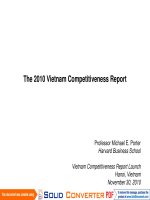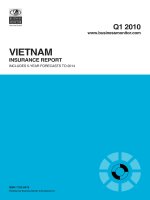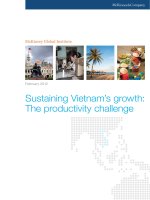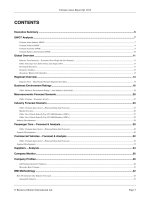Vietnam ma report 2015
Bạn đang xem bản rút gọn của tài liệu. Xem và tải ngay bản đầy đủ của tài liệu tại đây (1.9 MB, 97 trang )
Thuan Nguyen, FCCA
Lan Nguyen
Giang Ha
Anh Nguyen
CEO
Research Manager
Research Associate
Research Assistant
StoxPlus Corporation
StoxPlus Corporation
StoxPlus Corporation
StoxPlus Corporation
+84(4) 35626962 (ext. 111)
+84(4) 35626962 (ext. 109)
+84(4) 35626962 (ext. 109)
+84(4) 35626962 (ext. 109)
This page is intentionally left blank
Vietnam M&A Research Report 2015 | Issue 5 | 13 February 2015
2
Table of contents
PREFACE
4
ACRONYMS
5
EXECUTIVE SUMMARY
THE ECONOMIC CONTEXT
6-8
9-17
VIETNAM M&A ACTIVITIES REVIEW
18-40
THE REALIZATION OF OPPORTUNITIES FROM SOE EQUITIZATION
41-70
PERSPECTIVES OF FOREIGN INVESTORS ON SOE IPOS: A STOXPLUS SURVEY
71-78
TOP 10 UPCOMING SOE IPOs
79-84
Appendix: Top 40 In-bound M&A Transactions Factsheet
85-93
Important Disclosures
94
Our Survey
95
Our Methodology
96
About StoxPlus Corporation
97
@ 2014 StoxPlus Corporation.
All rights reserved. All information contained in this publication is copyrighted in the name of StoxPlus, and as such no part of this publication may be reproduced,
repackaged, redistributed, resold in whole or in any part, or used in any form or by any means graphic, electronic or mechanical, including photocopying,
recording, taping, or by information storage or retrieval, or by any other means, without the express written consent of the publisher.
Vietnam M&A Research Report 2015 | Issue 5 | 13 February 2015
3
Preface
We are pleased to bring to you the Vietnam
M&A Research Report 2015 (Issue 5). In
addition to the M&A data mining, we also
focus on equitisation progress of Vietnamese
State-owned enterprises including IPOs,
divestures from non-core businesses and
equitized SOEs in this Issue.
In this year, the recorded deals from SOEs are
only a few. However, we believe SOE
restructuring progress will be accelerated
quickly in coming period, and new
opportunities for M&A will emerge from
second wave of equitisation, the prominent
trend which has been analyzed in our recent
issues.
Our M&A report utilized extracted database
with over 15 years of historical data in
Vietnam. In addition to data analysis, the
report also relies on the authors extensive
knowledge and experience in advising deals in
Vietnam. We have surveyed relevant foreign
and local institutional investors as well as
conducting a number of in-depth interviews in
with experienced M&A advisers and
Government officials in during our
preparation.
About StoxPlus
This report is prepared by a team of
experienced analysts, researchers and data
clerks at StoxPlus. StoxPlus is a leading
financial and business information provider in
Vietnam. Our services include provision of
high quality data feeds, analytic tools and
market research.
StoxPlus is now serving a client portfolio of
over 100 corporate data clients including
securities companies, research houses, asset
managers, investment companies, and
thousands of sophisticated individual
investors.
Our Research division has been established as
an independent research house in Vietnam to
provide local insights to our clients at quality
standards of the World’s prestige advisory
firms.
If you have any questions about this report or
our services, please don not hesitate to
contact Thuan Nguyen, CEO of StoxPlus at
or +84- 4-3562
6962, ext 111.
We strongly believe that this report will be
valuable to institutional investors, investment
companies and foreign players who are
considering M&A as a strategy to set a
foothold or to expand their businesses in
Vietnam.
Vietnam M&A Research Report 2015 | Issue 5 | 13 February 2015
4
Acronyms
No.
1
2
3
4
5
6
7
8
9
10
11
12
13
14
15
16
17
18
19
20
21
22
23
24
25
26
Word
AEC
AnDate
ASEAN
BOD
CAGR
CF
ECs
EGs
FTAs
GCs
GRDI
GSO
HNX
HOSE
IPSI
MAC
MARD
MM
MNCs
SBV
SCs
SEGs
SOE
SSC
TBT
WEF
Stands for
ASEAN Economic Community
Announcement Date
Association of Southeast Asian Nations
Board of Directors
Compound Annual Growth Rate
Consumer Finance
Economic Corporations
Economic Groups
Free Trade Areas
Government Corporations
Global Retail Development Index
General Statistics Office
Hanoi Stock Exchange
Ho Chi Minh City Stock Exchange
Industrial Policy and Strategy Institute
Middle and Affluent Class
Ministry of Agriculture and Rural Development
Money Market
Multi-National Corporations
State Bank of Vietnam
State Corporations
State Enterprise Groups
State Owned Enterprise
State Securities Commission
Technical Barriers to Trade
World Economic Forum
Vietnam M&A Research Report 2015 | Issue 5 | 13 February 2015
5
Executive Summary
Inbound M&A by country, 2014
Vietnam M&A market is back on an upward trend
with deal value totaling US$4.66bn: StoxPlus’
database recorded 265 completed M&A deals in 2014
with value totaling US$4.66bn, an increase of 33.1%
from 2013 (total deal value recorded by StoxPlus in
2013 was US$ 3.504bn). The US$4.66bn did not take
into account a major real estate project Vung Ro
Resort by Rose Rock Group and Vung Ro Petroleum Ltd.
with a total investment of US$2.5bn, as the
disbursement for the project is still unclear. If
counting this project, the total M&A deal value in 2014
could reach US$7.16bn.
Thailand
US
Malaysia
Israel
Hong Kong
Japan
Singapore
UK
Indonesia
Denmark
Finland
Undisclosed
Norwegian
NGO
Ireland
South Korea
Luxembourg
France
• M&A activities in 2014 also increased in terms of
number deals, with 265 completed deals compared
to 196 deals in 2013, and nearly reached the record
of 267 deals in 2011 (when Vietnam M&A market was
at its peak). Vietnam M&A market has clearly shown
signs of warming up in 2014, with more activities as
well as major mega deals.
-100
Vietnam M&A deal value, 2003 – 2014
100
300
Minority
400
Number of deals
295
300
250
166
200
150
100
50
7,000
345 6,319
350
41
118
23
34
22
61
38
299
700
900
Majority
Number of deals
108
1,750
1,719
1,1171,140
267 5,142
6,000
4,663
5,000
3,504 265 4,000
173
3,000
196
-
2,000
1,000
-
2003 2004 2005 2006 2007 2008 2009 2010 2011 2012 2013 2014
The increase in deal value in 2014 was driven by a
number of mega-deals. There were 07 M&A deals in
2014 whose deal value was at least US$100mn,
including: Berli Jucker Pcl acquiring Metro Cash &
Carry Vietnam, SapuraKencana Energy acquiring two
oil blocks in Cuu Long Basil, Mondelez acquiring Kinh
Do Confectionery, and four other real estate
projects. Total value of these 07 mega-deals
amounted to US$2.44bn, or 52% of the total Vietnam
M&A market in 2014. It was due to the presence of
mega-deals that Vietnam M&A market had such a big
jump in deal value in 2014 compared to 2013.
Vietnam M&A Research Report 2015 | Issue 5 | 13 February 2015
Value US$mn
Deal Value
500
Thai investors led the inbound investment trend
in 2014, and Thai interest is expected to
increase in the coming years. Inbound M&A into
Vietnam totaled US$3.024bn in 2014, an big jump
of 64.9% compared to only US$1.83bn of inbound
M&A in 2013. This proved the regained confidence
and interest of foreign players for Vietnam market.
In terms of deal value, Thai investors ranked first
among countries and territories investing in
Vietnam with only 01 deal but investment value is
US$870mn (Berli Jucker Pcl acquiring Metro Cash &
Carry Vietnam), equivalent to 29.1% of total
inbound deal value. United States ranked second in
terms of deal value, with 07 deals totaling
US$498.6mn.
Sector appetite of foreign investors has not
changed much, still focusing mostly in
consumers-oriented sectors (food & beverage,
retail, real estate), and oil & gas. Foreign investors
still find it attractive to take advantage of the big
consumer base in Vietnam, and this theme will
likely to continue in the coming years. Oil & gas
acquisitions mostly happen at the upstream, where
foreign companies acquire oil blocks within
Vietnam’s water territory, as local companies are
still limited in their oil exploitation capabilities.
6
Executive Summary (cont’d)
The acceleration of SOE privatization: According the
data announced by the Government, over the period
2011 – 2014, there has been 247 SOE IPOs. Among
which, StoxPlus was able to identify 169 IPOs via public
and our own sources. The rest 78 IPOs were
unidentified. There were 148 SOE IPOs in 2014 itself
given the above Government’s efforts, signaling a
promising prospect for SOE IPOs in 2015.
Upcoming IPOs by sector
Number
of IPOs
Charter Capital
(in VNDbn)
190
2,461
Oil & Gas
1
1,550
Telecommunications
6
750
Utilities
47
437
Even though the quantity of SOE IPOs has been
increasing, the quality of IPO reflected in average
percentage of private investors shares after public
auction was an issue. Overall, the Government still
holds 90% on average after IPO of one SOE.
Retail
27
426
Food & Beverage
32
414
Financial Services
8
278
Travel & Leisure
14
263
Personal & Household Goods
21
256
Consequently, M&A activities generated from SOE IPOs
were minimum: Only 37 SOE IPOs attracted
institutional investors and led to M&A deals (1.16% in
market capitalization value and 14.7% in deal number).
Real Estate
17
190
Basic Resources
23
136
Health Care
10
96
Media
25
76
Chemicals
4
14
Technology
3
5
SOE IPOs from 2008 - 2015
284
300
250
200
148
150
105
100
74
50
12
13
2011
2012
0
2008-2010
2013
2014E
2015F
There are still many investment opportunities from
the SOE IPOs: As stipulated in Decision 929 issued on
July 17th 2012, the Government committed to a plan
to equitize 531 SOEs by the end of 2015. Hence, the
actualization of IPO plans at remaining SOEs is
expected to be aggressively urged in the coming year.
The promising sectors for M&A of SOE IPOs will come
from Telecommunications, Constructions and
materials, Retail, and Travel & Leisure.
Vietnam M&A Research Report 2015 | Issue 5 | 13 February 2015
Sector
Construction & Materials
Divestment progress from non-core business of
SEGs and SCs has been slow: Divestment from noncore business of SEGs and SCs are an important part
of the overall SOE restructuring process. As of 2014,
the Government has approved the Restructuring Plan
of 20/20 SEGs and SCs until 2015, which details the
list of companies to be divested. According to
StoxPlus database, there are 296 companies that
SEGs and SCs are required to divest or fully divest by
2015.
According to StoxPlus’ review from public sources,
out of the 292 required divestment, only 18% or 52
companies have been divested, 6% are currently in
the divestment process, and the rest are either
unidentified (36%) or having no plan on divestment
(40%).
7
Executive Summary (cont’d)
There has been little divesture of existing state
capital from already equitized SOEs. From our review
of changes in State Capital at listed companies on
HOSE, HNX and Upcom, 2014 marked a humble year of
divesting State Capital at equitised companies. In
particular, only 121 divestures were resulted from 941
entities being listed on Stock Exchanges or managed by
SCIC.
As a result of these divestures, average ownership level
of State reduced slightly from 36.06% in 2013 to 36.01%
in 2014 on the stock market, including companies on
HOSE, HNX and UpCom. Even though the Government is
directing enterprises to divest State Capital, this
change is minimal in comparison with desirable level of
State ownership in the whole market.
According to StoxPlus’ targeted survey of foreign
investors, foreign interest in SOE IPOs is high:
Investors regards highly the M&A opportunities from
SOE equitization process: 11% are very positive, 53%
positive, 31% neutral, and only 5% are not at all
positive about SOE equitization. This is a very
positive sign for higher foreign participation in SOE
IPOs and divestment in the coming year.
Overall interest of foreign investors in SOE equitization
Overall sentiment: How positive are you with M&A opportunities from
SOE equitization?
Not at all
positive
5%
Very positive
11%
Listed companies with State holding over 50%
chartered capital
Sector
Retail
Insurance
Real Estate
Technology
Oil & Gas
Financial Services
Energy
Travel & Leisure
Industrial Goods & Services
Household Goods
Chemicals
Banks
Automobiles & Parts
Basic Resources
Food & Beverages
Media
Telecommunications
Construction & Materials
Healthcare
# of Company
4
5
9
2
3
3
28
7
State Ownership
63%
62%
59%
50%
59%
74%
60%
63%
57
9
13
3
3
20
20
4
1
65
2
56%
62%
61%
79%
51%
61%
58%
51%
51%
58%
51%
Neutral
31%
Positive
53%
However, there are still many key challenges and
issues that need to be overcome to make SOEs
more attractive, in particular the disclosure of
information for investment opportunity screening:
The biggest challenge faced by foreign investors is
the lack of transparency and information about the
SOEs and their IPO plans.
StoxPlus faced the same issue when documenting
this report. Despite our thorough research
methodology and extensive data mining from various
sources, we were only able to identify 169 IPOs out
of 247 IPOs, or 68% of the total SOEs that have been
reported to be equitize by the Government’s report.
The rest 78 IPOs are unknown.
Without the information about the SOEs and their
IPO / equitization plans, it would be impossible for
investors to screen for investment opportunities in
the SOEs. Hence, transparency is the first and
foremost important issue that needs to be improved
by the SOEs in order to accelerate the equitization
process.
Vietnam M&A Research Report 2015 | Issue 5 | 13 February 2015
8
Section 1: The economic context
Vietnam M&A Research Report 2015 | Issue 5 | 13 February 2015
9
Section 1: The Economic Context
Vietnam Economy Context in 2014 – An economy in recovery
• Vietnam economy saw clearer signs of recovery in 2014. Since 2013, Vietnam economy started seeing signals
of recovery after economic crisis topped in 2012. This year 2014’s GDP achieved an estimated growth of 5.98%
against 2013 while having inflation at the lowest rate over 10 years.
• During 2014 the country’s sovereign risk ratings has been improved which allowed government bonds to be
issued on international capital markets, raising US$1 billion with higher capitalization level and more
favorable terms. Also, Vietnam has risen two spots ranking in the World Economic Forum’s (WEF) Global
Competitiveness Report 2014–2015. The country now ranks the 68th out of 144 countries.
Figure 1: Vietnam GDP Growth 2005 – 2014
(% y-o-y)
Figure 2: GDP Growth by sector 2014 (%)
3.49%
8%
20%
8
6%
15%
6
4%
10%
2%
5%
0%
0%
Q1/2009
Q2/2009
Q3/2009
Q4/2009
Q1/2010
Q2/2010
Q3/2010
Q4/2010
Q1/2011
Q2/2011
Q3/2011
Q4/2011
Q1/2012
Q2/2012
Q3/2012
Q4/2012
Q1/2013
Q2/2013
Q3/2013
Q4/2013
Q1/2014
Q2/2014
Q3/2014
Q4/2014
In a recovering trend
GDP Growth
7.14%
5.96%
4
2
0
CPI
Source: StoxPlus from GSO
Source: StoxPlus from GSO
• The economic growth is critically supported by continuous stability of macroeconomic environment. In terms
of GDP growth in details, we determine that strengthening services sector as well as industrial and
construction sectors were the key drivers. Besides, relatively flat domestic demand has stimulated even
faster recovery.
Vietnam M&A Research Report 2015 | Issue 5 | 13 February 2015
10
Section 1: The Economic Context
Monetary policy played an important role in stabilizing the economy
This page is intentionally left blank
Figure 3: Short-term rates 2008 - 2014
Figure 4: Exchange rate fluctuation 2012 - 2014
Source: StoxPlus from VCB
Source: StoxPlus from VCB
Figure 5: Inflation rate 2009 – 2014 (%)
[VALUE]%
20
15
10
[VALUE]%
CPI rate
Source: StoxPlus from GSO
Vietnam M&A Research Report 2015 | Issue 5 | 13 February 2015
11
Jul-14
Oct-14
Apr-14
Jan-14
Jul-13
Oct-13
Apr-13
Jan-13
Jul-12
Oct-12
Apr-12
Jan-12
Jul-11
Oct-11
Apr-11
Jan-11
Jul-10
Oct-10
Apr-10
Jan-10
Jul-09
Oct-09
Apr-09
-
Jan-09
5
The story of State Budget deficit fuelled the divesture of State Capital
and acceleration of SOE IPOs
This page is intentionally left blank
Figure 6: State Budget of Vietnam 2004 - 2014
2004 2005 2006 2007 2008 2009 2010 2011 2012 2013 2014
0
-1
-2
% GDP
-3
-4
-5
-6
-4.9
-4.9
-4.6
-5.0
-4.9
-5.6
-5.7
-7
-8
-4.8
-5.3
-5.3
-6.9
Budget Deficit
Source: StoxPlus from ADB & GSO
Vietnam M&A Research Report 2015 | Issue 5 | 13 February 2015
12
Vietnamese private enterprises gradually recovered from distress
situation
• In our previous Vietnam M&A Research Report, Issue 2 dated back from 2012 during the heart of economic
crisis, we analyzed the trend that ASEAN firms increasingly acquired controlling stake in Vietnamese
distressed companies. During the economic downturn 2009 - 2012, many of Vietnamese enterprises are
described as being financially distressed due to excessive financial leverage and extremely high cost of
capital (for example, many cement companies such as Thang Long Cement had Debt to Equity (D/E) ratio
of 11 as of year-end 2012). Even though these enterprises has strong fundamental operation, it was
payment of financial loans that threatened their business. Those business issues are severely affected by
the prolonged domestic economic recession. All of the above made the valuation of Vietnamese enterprises
very low during the period, which generated opportunities for foreign investors to implement their strategy
to expand operation into Vietnam market through M&A. The M&A in this period is recognized by many
acquisition of banks, enterprise’s conversion of debt to equity, acquisition of foreign investment firms with
distress enterprises.
• However, this trend is unlikely to be continue in this period given several major economic signals:
This part is intentionally left blank
Vietnam M&A Research Report 2015 | Issue 5 | 13 February 2015
13
Section 1: The Economic Context
FDI disbursement in Vietnam is increasing
This page is intentionally left blank
Figure 7: FDI registered 2000 - 2014
Source: StoxPlus from MPI
Figure 8: FDI registered by country 2014
Source: StoxPlus from MPI
Figure 9: FDI registered by sector 2014
2%
2%
6%
5%
13%
72%
Source: StoxPlus from MPI
Vietnam M&A Research Report 2015 | Issue 5 | 13 February 2015
14
M&A deals from FII is becoming popular given the rise of FII inflow
Figure 10: FII into Vietnam 2003 - 2014
This page is intentionally left blank
Source: StoxPlus from SSC
Figure 11: M&A deals of listed companies 2011 – 2014
Year
2011
2012
2013
2014
Total
# of Deal/ Total Deal
153/901
Source: StoxPlus from SSC
Vietnam M&A Research Report 2015 | Issue 5 | 13 February 2015
15
Section 1: The Economic Context
Regulation development is becoming catalyst for M&A acceleration
• During period 2014-2015, the effectiveness of several regulations contributed positively on the dynamics of
M&A market in Vietnam. Those regulations include Circular 111/2013/TT-BTC, Circular 36/2014/TT-NHNN,
Resolution 15/NQ-CP and Decision 37/2014/QD-TTg.
• Circular 111/2013/TT-BTC: On the implementation of Law on Personal Income Tax
Effective date: October 1st 2013
Key features relating to M&A:
Regarding incomes from transferring shares, call options on shares, bonds, treasury bills… and
incomes from transferring shares of the persons in the joint-stock company according to the Law on
Enterprises. If the share owner is Vietnam resident, he/she has the options of either paying PIT
equally 0.1% transaction value or 20% profits generated from the transferring of shares.
Implication for M&A:
Previously, there is no clear information on which treatment of PIT calculation shall be applied for
income from transferring of shares at local JSC. Circular 111 opened up clear options for shareholders
and reduced their stress on PIT calculation treatment, allowing their transferring process to be
accelerated. As a result, M&A activities is encouraged to increase.
• Circular 36/2014/TT-NHNN: Stipulating minimum safety limit and ratios for transactions performed by
credit institutions and branches of foreign banks
Effective date: February 1st 2015
Key features relating to M&A:
Regarding commercial bank’s purchase and holding of stocks of other credit institutions: Commercial
banks are only entitled to purchase or hold stocks of fewer than two (02) other credit institutions;
Also, commercial banks could hold stocks of another credit institution at the rate of below 5% of
voting stocks of these credit institutions.
Implication for M&A:
The effective of this regulation shall contribute to eliminate cross-holding issue at commercial banks,
which is one of the biggest issues in Vietnam banking system today. As banks are forced to divest
stake at other banks, M&A opportunities will come to private investors who plan to acquire those
stake in 2015.
•
Resolution 15/NQ-CP and Decision 37/2014/QD-TTg: Solutions for speeding up equitisation and
withdrawal of state capital from enterprises, and criteria for enterprises holding by the State.
Effective date: February 1st 2015 and August 6th 2014 respectively
Key features relating to M&A:
Based on the criteria and classification of state enterprises and their role in development of sectors,
state groups, corporations and enterprises shall determine the holding rate of state capital which
must not exceed 65% of the charter capital. The Government determined categories of SOEs which
the State holds a certain level of ownership.
Implication for M&A:
The Government has strongly enforces equitisation process of SOEs and a lot of attractive SOEs shall
be equitised in period 2014 – 2016. Many SOEs which are not fall within criteria for holding by the
State shall be fully divested. The huge divesture of capital is bringing opportunities for M&A as
private investors are given access to SOE stake.
Vietnam M&A Research Report 2015 | Issue 5 | 13 February 2015
16
Section 1: The Economic Context
Some international trade agreements will significantly increase
investment flow into Vietnam from 2015
Agreement
TPP
ASEAN FTA
Vietnam – Korea
FTA
Overview
TPP is a giant free trade
area deal of 12 countries
including US, Canada,
Mexico, Peru, Chile, New
Zealand, Australia,
Malaysia, Singapore,
Vietnam, Brunei and
Japan. It's expected to
eliminate tariffs on goods
and services, tear down a
host of non-tariff barriers
and harmonize all sorts of
regulations
Key Features
•
Tariffs: Cut most of the tariff lines (at least 90%)
•
Services: Increase the openness of service sector, particularly
financial services
•
Investments: Strengthen the provisions relating to foreign
investment and investor protection
•
Intellectual Property Rights: Increase the level of protection
of intellectual property rights higher than the WTO (WTO +)
•
Measures SPS, TBT: Tighten the requirements for sanitary and
phytosanitary and technical barriers
•
Competition and public procurement: Enhance competition,
especially in the field of public procurement
•
The labor problems: especially the issue of the right of
association (union), the right to collective negotiations and
general laborers, regulations prohibit the use of all forms of
forced labor, prohibition exploitation of child labor, the
provisions do not discriminate in the labor force
AFTA is a free trade area
agreement which aims to
the reduction and
elimination of tariffs
among items and sensitive
agricultural products of
member countries in South
East Asia (Brunei,
Cambodia, Indonesia, Laos,
Malaysia, Myanmar,
Philippines, Singapore,
Thailand, Vietnam)
•
Items' reduction and elimination of tariffs: tax rate decreased
to 0-5% by 2006 and eliminate tariffs in 2015, with some
flexible items in 2018.
•
Items of information technology (consistent with an item of
WTO) will eliminate tariffs in 3 years: 2008-2010. 12 fields
will be removed earlier than in 2012 (instead of 2015), which
has 9 fields of goods including timber and wood products,
automotive , rubber, textiles, agricultural products, aquatic
products, electronics, information technology, healthcare
(equipment, drugs).
•
Sensitive agricultural products: including 89 tariff lines which
are agricultural products, unprocessed, including some types
of rice, fruit, food, sugar. These items do not have to
eliminate tariffs, with tariff reduction schedules from current
tariff in 2004 to the highest tax rate 5% in 2013 (except for
the road is 2010).
The FTA shall remove
import tariffs of over 90%
of all products traded
between Vietnam and
Korea.
•
The newly finished bilateral agreement shall regulate the
trade of goods and services, customs procedures, intellectual
property standards, food hygiene and safety, and origin rules.
Besides, it commits to remove e-commerce and legal
institutions barriers.
•
Key business areas affected by the agreement include
automotive, electronics, and textiles sectors. Goods receiving
preferential treatment include plastic materials, steel
products, electrical cable, home appliances, and specific high
cc vehicles.
•
South Korea shall cut import tariffs on farm products,
seafood, garments and textiles and mechanical products from
Vietnam. Rice which is classifies as a sensitive product by
South Korea was not included.
Vietnam M&A Research Report 2015 | Issue 5 | 13 February 2015
Potential effects to
M&A market
According to MPI, FDI from
TPP countries has made up
50% of total FDI into
Vietnam. Participation of
Vietnam in TPP will
significantly increase
investment capital flow in
supporting industries, value
added services and the
technology sector due to
the free investment rule
regulated by the TPP
agreement. Sectors which
Vietnam has competitive
advantages shall witness
acceleration of M&A.
With the elimination of
tariffs within ASEAN,
trading within the
community is considered as
local trading. Given the
consumption growth
potential of Vietnam, FDI
from ASEAN countries and
inbound M&A in
agricultural productions,
retails and services are
expected to increase
exponentially. For
example, 2014 marked a
year of emerging Thai
inbound M&A into Vietnam.
Currently Korea is the
biggest FDI investor into
Vietnam. The FTA is
expected to triple bilateral
trade between two
countries up to US$70
billion by 2020, indirectly
supporting growth of
inbound and outbound M&A
between Vietnam and
Korea.
17
Section 2: Vietnam M&A
Activities Review
Vietnam M&A Research Report 2015 | Issue 5 | 13 February 2015
18
Section 2: Vietnam M&A Activities Review
M&A market is back on an upward trend with 265 deals valuing
US$4.70bn in 2014
• The growth of Vietnam’s GDP reached 5.9% in 2014, an increase of 5.42 % compared to 2013, making Vietnam the
second fastest growing economy in the world (behind China). After a few years being slowed down due to the
economic crisis, Vietnam economy has gradually stabilized. In the same trend with the macro economy, Vietnam
M&A market also showed signs of recovery in 2014 after two years on a declining trend.
Figure 12: Vietnam M&A deal size and number of deals, 2003 – 2014
Source: StoxPlus
Notes: 28 out of 265 deals do not disclose their deal values and do not provide reasonable estimation basis.
This page is intentionally left blank
Vietnam M&A Research Report 2015 | Issue 5 | 13 February 2015
19
Section 2: Vietnam M&A Activities Review
Deal size analysis: Mega deals in 2014
Figure 13: M&A deal size, 2014
7 mega-deals (deal
value of at least
US$100mn)
accounted for 52% of
total Vietnam M&A
market in 2014
Source: StoxPlus
This page is intentionally left blank
Vietnam M&A Research Report 2015 | Issue 5 | 13 February 2015
20
Section 2: Vietnam M&A Activities Review
Vietnam M&A Marker 2014: Further Data and Figures
Figure 14: Breakdown of deals by value in 2014
Inbound
64.9%
This part is intentionally left blank
Domestic
35.0%
Outbound
0.1%
Source: StoxPlus
Figure 15: M&A Vietnam Market 2014, by sector
US$m
2014
Value
Vol (#)
Minority
Majority
Real Estate
Retail
Food & Beverage
Oil & Gas
Chemicals
Construction & Materials
Industrial Goods & Services
Banks
Personal & Household Goods
Travel & Leisure
This part is intentionally left blank
Financial Services
Utilities
Technology
Basic Resources
Health Care
Automobiles & Parts
Media
Consulting
Total
Source: StoxPlus
Vietnam M&A Research Report 2015 | Issue 5 | 13 February 2015
21
Section 2: Vietnam M&A Activities Review
Vietnam M&A Marker 2014: Further Data and Figures
Figure 16: M&A Vietnam Market 2014, by sub-sector level 4
US$mn
2014
Value
Real Estate Holding &
Development
Food Products
Oil & Gas
Milk
Banks
Farming, Fishing and
Plantations
Transportation Services
Commodity chemicals
Clothings & Accessories
Heavy Construction
Building Materials &
Fixtures
Fertilizer
Coal
Restaurants & Bars
Consumer Finance
Telecommunications
Equipment
Conventional Electricity
Travel & Leisure
Beverage
Specialty Chemicals
Electricity
Pharmaceuticals
Automobiles
Hotels
Investment Services
Containers & Packaging
US$mn
Vol (#)
2014
Value
Vol (#)
Integrated Oil & Gas
Securities
Technology
Gas distribution
Property & Casualty
Insurance
IT
Furnishings
Nondurable Household
Products
Recreational Services
Industrial Machinery
Oil Exploration
Education
Diversified Industrials
Broadline Retailers
Mining
Rubber
Retail
Iron & Steel
Car
Commercial Vehicles &
Trucks
Specialty Finance
Electrical Components
& Equipment
Forestry
Cement
Electric & telecom
material
Industrial supplier
Water
Source: StoxPlus
Vietnam M&A Research Report 2015 | Issue 5 | 13 February 2015
22
Section 2: Vietnam M&A Activities Review
Inbound deals dominate with 70% of M&A deal value
Figure 17: Breakdown of deals by Domestic, Inbound, and Outbound
This page is intentionally left blank
Figure 18: Inbound M&A, 2013
Figure 19: Inbound M&A, 2014
Singapore
United States
Korea
Russia
Others
Hong Kong
Japan
Finland
UK
Canada
Thailand
Indonesia
Denmark
Norwegian
Malaysia
Cayman Islands
Australia
India
Luxembourg
Source: StoxPlus
100.0 200.0 300.0 400.0 500.0 600.0
Minority
Majority
Vietnam M&A Research Report 2015 | Issue 5 | 13 February 2015
23
Section 2: Vietnam M&A Activities Review
Inbound M&A by Country: Thailand spotlight
This page is intentionally left blank
Figure 20: Thailand M&A deals from 2011 – 2014
Source: StoxPlus
Profile of SCG
Vietnam M&A Research Report 2015 | Issue 5 | 13 February 2015
•
SCG was established in
1913 following a royal
decree of His Majesty
King Rama VI to produce
cement, the main
building material for
infrastructure projects.
•
SCG has grown
continually and
diversified into three
core businesses, namely
SCG Cement-Building
Materials, SCG Paper and
SCG Chemicals.
24
Section 2: Vietnam M&A Activities Review
Inbound M&A by Country: Thailand spotlight
Profile of BJC
•
Building Partnerships in
Thailand since 1882
•
The company’s inception
was first created through
a partnership between
the Berli and Jucker
families.
•
Originally, BJC engaged
in rice milling, mining,
timber, shipping,
importing, and other
activities.
•
BJC prospered over the
years to become a major
Thai import and export
firm.
This page is intentionally left blank
Profile of ThaiBev
Vietnam M&A Research Report 2015 | Issue 5 | 13 February 2015
•
ThaiBev was
established in 2003.
•
ThaiBev is not only
Thailand is leading
beverage producer,
but also one of Asia is
largest beverage
producers.
•
Their business consists
of four segments:
spirits, beer, nonalcoholic beverage,
and food.
25









